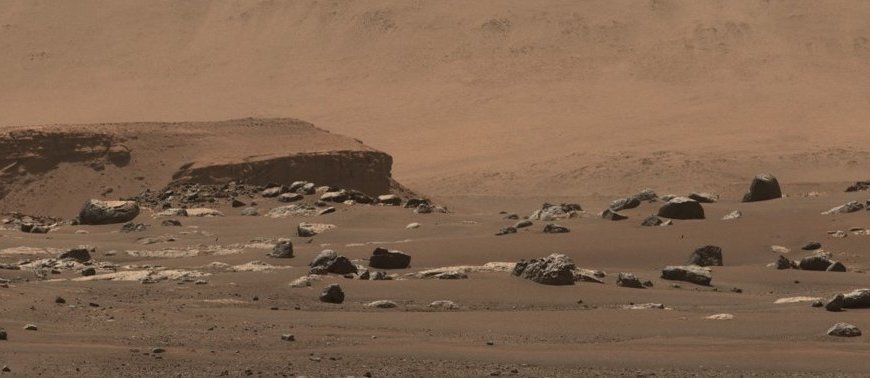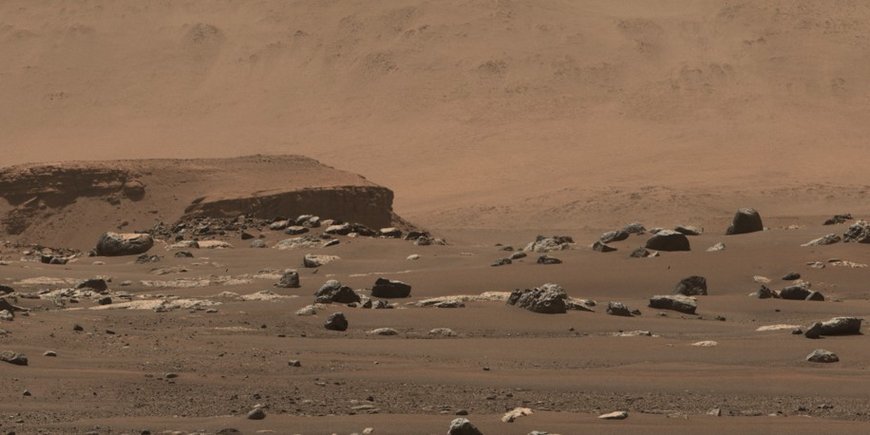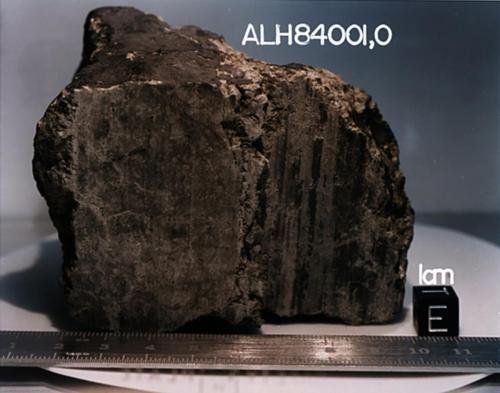Summary
How organic molecules formed on Mars and other planets has long been the subject of controversy. Both biological and abiotic processes come into consideration. Now, measurements on the four-billion-year-old Martian meteorite Allan Hills (ALH) 84001, show that even at this early stage on Mars, abiotic reactions between rock and water led to the formation of organic carbon molecules. The researchers identified two possible but linked reaction pathways. This also allows conclusions to be drawn about the development of life on Earth. The study was led by Andrew Steele of the Carnegie Institution for Science in Washington D.C., USA, with the collaboration of Liane G. Benning of the German Research Centre for Geosciences Potsdam (GFZ), Germany, Diamond Light source in the UK as well as NASA and others. It has been published in the journal Science.
Organic substances on Mars and their significance for Mars and Earth history
Even before probes and robots flew to Mars, meteorites from our neighbouring planet provided materials for scientific investigations. The rock fragment Allan Hills (ALH) 84001, found in Antarctica in 1984, is considered one of the oldest known objects on Earth that originated from Mars. Organic substances were found in it, the origin of which has been controversially discussed ever since its discovery.
“Analyzing the origin of the meteorite’s minerals can serve as a window to reveal both the geochemical processes occurring early in Earth’s history and Mars’ potential for habitability,” explains Andrew Steele, who has done extensive research on organic material in Martian meteorites and is a member of both the Perseverance and Curiosity rovers’ science teams.
Organic molecules contain carbon and hydrogen, and sometimes include oxygen, nitrogen, sulfur, and other elements. Organic compounds are commonly associated with life, although they can be created by non-biological processes as well, which are referred to as abiotic organic chemistry.
The origin of the organic compounds in the meteorite studied here could be various abiotic processes related to volcanic activity, impact events on Mars or hydrological exposure, as well as potentially the remnants of ancient life forms on Mars or contamination from its crash landing on Earth.
New research by a large international team
Now a large international team led by Andrew Steele of the Carnegie Institution for Science in Washington D.C., with the collaboration of Liane G. Benning and others from the GFZ, has again analysed the identity, origin and formation mechanisms of the organic compounds in AHL 84001. NASA Johnson Space Center, NASA Ames Research Center and Rensselaer Polytechnic Institute (all USA) as well as Diamond Light Source (UK) team members were also involved.
The researchers examined wafer-thin samples of the meteorite and used a range of sophisticated sample preparation and analysis techniques, including nanoscale imaging and spectroscopic analyses using transmission electron microscopy, synchrotron scanning transmission X-ray microspectroscopy as well as isotopic analysis.
Some of the substances analysed were present in only very low concentrations. This made the analysis very complex. "It was also important to make sure that we were actually measuring substances that were formed on Mars and not during the flight to Earth, during or after landing or even during our experiments," emphasises Liane G. Benning, head of the GFZ's Interfacial Geochemistry Section and professor at the FU Berlin. She has been researching meteorites - among other things - with Andrew Steele for more than a decade. She states: “Through co-localised nanoscale micro-spectroscopic analyses we documented how minerals in this meteorite reacted with a CO2 saturated brine and catalysed the formation of abiotic carbon on Mars.”
Abiotic interaction between water and rock as the origin of organic molecules
In fact, the team found evidence of interactions between water and rock in the samples from the Martian meteorite that created organic molecules. These interactions are similar to those on Earth. In particular, the research suggests that two important geochemical processes took place in the Martian rock: One, called serpentinization, occurs when iron- or magnesium-rich igneous rocks chemically interact with circulating water, changing their mineralogy and producing hydrogen in the process. The other, called carbonization, involves interaction between rocks and slightly acidic water containing dissolved carbon dioxide and results in the formation of carbonate minerals.
It is unclear whether these processes were induced by surrounding aqueous conditions simultaneously or sequentially, but the evidence indicates that the interactions between water and rocks did not occur over a prolonged period. What is evident, however, is that the reactions produced organic material from the reduction of carbon dioxide.
These mineralogical features are rare in Martian meteorites, and while carbonation and serpentinization have been shown in orbital surveys of Mars and carbonation has been found in other, less-ancient, Martian meteorites, this is the first instance of these processes occurring in samples from ancient Mars. Organic molecules have been detected by Steele in other Martian meteorites and from his work with the Sample Analysis at Mars (SAM) team on the Curiosity rover, indicating that abiotic synthesis of organic molecules has been a part of Martian geochemistry for much of the planet’s history.
Significance for the history of Mars and Earth
“These kinds of non-biological, geological reactions are responsible for a pool of organic carbon compounds from which life could have evolved and represent a background signal that must be taken into consideration when searching for evidence of past life on Mars,” Steele concluded. “Furthermore, if these reactions happened on ancient Mars, they must have happened on ancient Earth, and could possibly explain the results we’ve from Saturn’s moon Enceladus as well. All that is required for this type of organic synthesis is for a brine that contains dissolved carbon dioxide to percolate through igneous rocks. The search for life on Mars is not just an attempt to answer the question ‘are we alone?’ It also relates to early Earth environments and addresses the question of ‘where did we come from?’”
(UD with material from the Carnegie Institution for Science)
Original study: A. Steele, L.G. Benning, et al. Organic synthesis associated with serpentinization and carbonation on early Mars. Science. Vol. 375, January 14, 2022. DOI: 10.1126/science.abg7905
Scientific contact:
Prof. Liane G. Benning
Section head Interface Geochemistry
Helmholtz Centre Potsdam
GFZ German Research Centre for Geosciences
Telegrafenberg
14473 Potsdam
Phone: +49 331 288-28970
Email: liane.benning@gfz-potsdam.de
Media contact:
Dr. Uta Deffke
Public and Media Relations
Helmholtz Centre Potsdam
GFZ German Research Centre for Geosciences
Telegrafenberg
14473 Potsdam
Phone: +49 331 288-1049
Email: uta.deffke@gfz-potsdam.de










![[Translate to English:] Torsten Sachs in front of a climate station on a field](/fileadmin/_processed_/3/9/csm__TorstenSachs_bearbeitet_GS_4a1365ef84.jpeg)

![[Translate to English:] left image flood at the Ahrtal: image from above, several houses are flooded; left image:: Heidi Kreibich;](/fileadmin/_processed_/4/4/csm_Bild2_9af0130e9f.png)



![[Translate to English:] Start der Vega Rakete](/fileadmin/_processed_/6/4/csm_20231201-kachel_Vega-VV23-launch_ESA-CNES-Arianespace_706716b68c.jpeg)









![[Translate to English:] Poster exhibition at the Brandenburg Hydrogen Day at the GFZ, some participants in the foreground](/fileadmin/_processed_/6/5/csm_Erster_Brandenburgischer_Wasserstofftag_GFZ_402fcec95e.jpeg)
![[Translate to English:] Group picture of the participants](/fileadmin/_processed_/9/4/csm_20231108_CAWa-Workshop-Tashkent_Gruppenbild_99ea779d8a.jpeg)

![[Translate to English:] [Translate to English:] Hörsaal](/fileadmin/_processed_/e/6/csm_H%C3%B6rsal_e21ac645fb.jpeg)


![[Translate to English:] The Delegations in the Historic Library on the Telegrafenberg. In the back there are from left to right, the Dutch Ambassador for Germany, Ronald van Roeden, the Dutch Minister for Education, Culture and Science, Robbert Dijkgraaf and the scientific director of the GFZ, Susanne Buiter.](/fileadmin/_processed_/d/b/csm_Kachel-2_9eba4b4212.jpeg)

